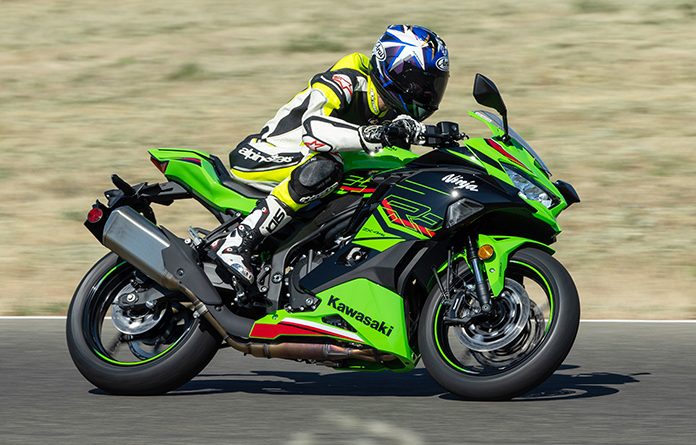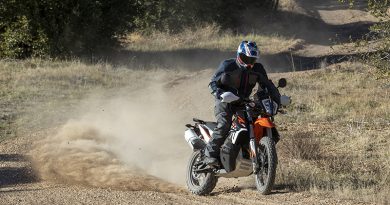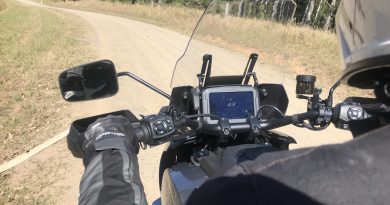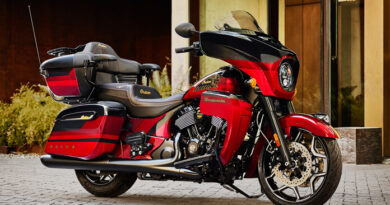2023 Kawasaki Ninja ZX-4RR | First Ride Review
It’s a rare situation when a motorcycle debuts in a class of its own, but that’s what we have here in the 2023 Kawasaki Ninja ZX-4RR. Sure, the Ninja 400 has been a popular member of Team Green for several years and is an excellent streetbike, but its parallel-Twin engine is far more pedestrian than the shrieking 4-cylinder motor in this little screamer that revs to 16,000 rpm.
Also important is how upscale this thing looks. It appears far more exotic than most other smaller-displacement sportbikes, resplendent in its Kawasaki Racing Team (KRT) color and graphics.
Adding to its upmarket presentation is TFT instrumentation, full LED lighting, an up/down quickshifter, traction control, and dual-disc front brakes with radial-mount monoblock calipers and standard ABS.
The ZX-4RR has the potential to reinvigorate the sportbike market, providing a gateway to high-level performance in a package that is both tamable and attainable. Its power naturally pales in comparison to a fire-breathing ZX-10R or even a ZX-6R, but the 124 mph shown on its speedometer at the end of Thunderhill Raceway’s front straight demonstrates its potential for speed.
Related: 2024 Kawasaki Ninja ZX-6R | First Look Review
Class Revamp
The 400cc sportbike market raged in the 1990s, with high-end race replicas from every Japanese OEM available in their domestic markets. American importers were skeptical that these pricey little bikes would find much appeal to riders on our shores, but Yamaha took a chance and offered its FZR400, which earned a reputation as one of the best-handling bikes of its era.
Production of the FZR400 began in 1987, and the bike was regularly updated until its demise in 1994. The Yamaha’s inline 4-cylinder used a 56.0 × 40.5mm bore and stroke said to produce 59 hp at 12,000 rpm, with an over-rev capability up to its 14K redline. Racy steering geometry ensured agility, aided by an aluminum frame that kept wet weight down to about 410 lb.
Sadly, I missed out on my chance to ride any of the 400s from that golden era, so I was stoked for the opportunity to test a contemporary version of this forgotten class.
A New Era
The Kawasaki Ninja ZX-4RR was primarily developed for Asian markets that have licensing and insurance regulations to encourage the use of smaller-displacement motorcycles. Just as Yamaha took a chance in the U.S. market with the lovable FZR400, Kawasaki is doing the same with this latest Ninja.
A common attitude about small-displacement sportbikes in bigger-is-better America has been that we’re not much interested in them, but the U.S. market is evolving. Kawasaki tells us that uptake on the 4RR has been strong at the dealer level thanks to the bike’s unique selling proposition.
Part of the Kawi’s distinctiveness is its ability to rev up to a stratospheric 16,000-rpm redline, which is higher than any engine offered in the USA aside from the Ducati Panigale V4R’s 16,500-rpm rev ceiling. The 4RR uses a more oversquare bore and stroke (57.0 x 39.1mm) than the FZR400 to safely achieve those lofty revs, along with forged camshafts and triple-rate valve springs.
Kawi’s USA arm doesn’t provide horsepower figures, but its Euro importer touts 76 crankshaft hp at 14,500 rpm. Torque peaks all the way up at 13,000 rpm with 28.8 lb-ft.
Related: 2020 Kawasaki Ninja 650 | Road Test Review
EPA Killjoy
Unfortunately, EPA noise regulations mean that the 4RRs coming to North America are restricted, most likely by way of the electronic throttle valves at high revs. Our 4RRs produce peak power around 11,500 rpm according to a dyno chart supplied by Graves Motorsports, just shy of 60 hp at the rear wheel. Upconverting that number to a rated-at-crankshaft figure translates to about 65 hp, at least 10 ponies down from its Euro spec.
The 4RR proved to be thrilling to ride, but I’d feel a little gypped to own one and not have access to the bike’s full potential. Bikes like these are frequently fitted with aftermarket exhaust systems that drastically increase the sound from the tailpipe, so the EPA’s intentions will likely have limited real-world impact.
If I owned one, the first thing I’d do is visit Graves Motorsports for an ECU reflash, even though that would be illegal in the eyes of the EPA. For trackday/racing use only, a reflash and a cat-back slip-on muffler from Graves results in a claimed 76 rear-wheel hp, a massive 37% increase. Yee-haw!
Racetrack Ready
Kawasaki could’ve cheaped out and hosted the 4RR’s launch with a street ride but thankfully made a bolder move and rented Thunderhill Raceway for us to divine the bike’s maximum performance potential. And we’re glad it did – flogging the newest Ninja on the entertaining and hilly racetrack in Northern California elicited countless grins and zero moments of panic.
The 4RR feels light and manageable upon first straddle of its 31.5-inch seat. It scales in at 415 lb with its 4-gallon tank full, which equates to about 390 lb of vehicle weight, despite a steel (rather than aluminum) frame. Ergonomics are sportier than the Ninja 400 but less punishing than Kawi’s ZX-6R or ZX-10R. The seat has a surprising amount of fore/aft room to accommodate riders of various sizes and changing body positions on the track.
The effort required to use the bike’s slip/assist clutch feels impossibly light, and both hand levers are adjustable over five positions to suit hands of any size. The 4.3-inch TFT features a Circuit Mode for lap timing and to display track-related information in an easier-to-view layout. Kawasaki’s Rideology app can connect the bike to smartphones.
The Kawasaki Ninja ZX-4RR includes two power modes – with a Low setting for less-experienced riders– and three ride modes (Sport, Road, and Rain) with preset Kawasaki TRaction Control (KTRC) and power modes. Also available is a Rider mode in which the systems can be set independently, including three levels of traction control with the ability to be switched off.
For my first session, I used Sport mode and kept the traction control at its least-intrusive setting. The 4RR doesn’t have an IMU to inform TC or braking, relying instead on wheel-speed differentials, so there’s no lean-sensitive TC or cornering ABS.
GEAR UP
Helmet: Arai Corsair-X Vinales-5 Replica
Suit: Alpinestars Missile
Gloves: Alpinestars GP Pro
Boots: Sidi Mag-1
It had been years since I had ridden Thunderhill, and the rider-friendly nature of the Ninja was an ideal accomplice to relearn the track. Pointing the bike at apexes required only modest effort. Gear changes were clicked off effortlessly thanks to clutchless upshifts and downshifts offered by the quickshifter, an easily visible gear-position indicator, and a tachometer that shows revs above 10,000 rpm at the top of the display.
After only a few laps, I was dragging knees in corners and cutting seconds off my early lap times, smiling in my helmet as the Ninja complied with my inputs. The little 4-cylinder engine screams with a wonderful wail as it sings to its redline, but it’s smarter to shift around 12,000 rpm when the power levels off due to the cursed EPA restrictions. Intake snorkels with differential lengths (40mm and 60mm) do their best to offer a broader spread of power, but you’ll want to rev the snot out of the little Ninja for the optimum experience.
Related: Kawasaki Announces More New and Updated 2023 Models
Star Power
During the next session, I found myself behind a rider I didn’t recognize from the motojournalist ranks. He was cutting some nice lines, and it was fun to catch him in some places and lose time in others during our little cat-and-mouse game.
At the end of our 30-minutes session, I walked over in the pits to say hello to this stranger and express the entertainment I got from dicing with him.
“Oh, hi, I’m Dax,” he replied.
Wait a minute…Dax? There can’t be many Daxs in the world, so I finally made the connection that I was ripping around with Dax Shepard: actor, podcaster, and husband of movie star Kristen Bell! It was delightful to see a celebrity with the ability to rip around a racetrack.
“Being broke in Michigan, what I would’ve loved was a Corvette ZR-1. I got my Katana 600 for $1,800 used, and it was faster than a ZR-1,” Shepard told us about his love for speed, which began with a humble Honda Spree.
“I’ve always been blown away by how inexpensive it is to have performance with a motorcycle,” said the co-host of Top Gear America. “I had a couple of different track bikes, and other than tires, I’d never done one thing to them. So the notion that you could have a vehicle that you could go to 20-plus trackdays and not be replacing rotors and pads and suspension components, it’s bang for the buck – the most fun anyone could have.”
Please, Sir, Can I Have Another?
Unlike a literbike, which can be exhausting to thrash around a racetrack, I remained raring to go even after full 30-minute sessions. What’s refreshing is time – time to ease your grip on the bars, time to breathe, time to analyze.
Although I didn’t feel traction control intruding much during previous sessions, I did notice ABS kicking in at a couple of braking zones. I ended up disabling traction control and ABS so I could ride unencumbered by the electronic nannies. Power application became more direct with a stronger pull out of corners, so TC surely had been kicking in during earlier stints.
I was initially worried about the grip from the stock Dunlop Sportmax GPR300 tires, which seemed to be a substandard choice for a trackday. Surprisingly, they stuck quite well, all the way up to and past footpeg-scuffing levels.
The suspension performed quite well for my weight, although heavier riders were making adjustments to the inverted Showa fork and fully adjustable Showa BFRC Lite shock that’s similar to the one used on the ZX-10R. The 37mm fork uses SFF-BP internals, in which the large-diameter damping piston provides more surface area to interact with oil, which allows the fork to move more smoothly during the initial part of its stroke. Adjustable spring preload on a fork is a first for this class, but it’s the only setting that can be altered.
The radially mounted 4-piston monoblock calipers and 290mm discs are plenty for bleeding speed from the 399cc engine and offer a decent amount of feedback. Switching off ABS offered a big improvement in confidence on the racetrack. The quickshifter was a huge benefit as well, with auto-blipping downshifts and the slipper clutch allowing hurried gear changes.
Who Wants One?
Being in a class of one, the 4-cylinder ZX-4RR stands apart from other small-displacement offerings. Its $9,699 MSRP enables the bike to have high-end features, but some will point out that a much more powerful ZX-6R costs only $2,600 more when equipped with ABS.
Or you could get the twin-cylinder Ninja 400 for as little as $5,699 with ABS, but then you’d miss out on TFT instruments, dual-disc front brakes, traction control, and adjustable suspension, plus you’d give up a bunch of power and the siren song of a high-revving four-cylinder motor.
It’s worth reiterating how much of a gigglefest it is to hammer a modestly powered but lightweight sportbike around a racetrack, even for riders with decades of experience on high-powered literbikes. And for those who might be taking to the track for the first time, a sporting motorcycle like the ZX-4RR is an ideal tool to learn how to do it properly. Mr. Graves, please send a reflashed ECU ASAP.
2023 Kawasaki Ninja ZX-4RR Specs
Base Price: $9,699
Warranty: 1 yr., unltd. miles
Website: Kawasaki.com
Engine Type: Liquid-cooled, transverse inline-Four, DOHC w/ 4 valves per cyl.
Displacement: 399cc
Bore x Stroke: 57.0 x 39.1mm
Horsepower: N/A
Torque: N/A
Transmission: 6-speed, cable-actuated slip/assist wet clutch, up/down quickshifter
Final Drive: Chain
Wheelbase: 54.3 in.
Rake/Trail: 23.5 degrees/3.8 in.
Seat Height: 31.5 in.
Wet Weight: 415 lb
Fuel capacity: 4.0 gal.
See all of Rider‘s Kawasaki coverage here.
The post 2023 Kawasaki Ninja ZX-4RR | First Ride Review appeared first on Rider Magazine.




